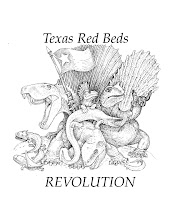Some days, he's got volunteers working on the sediments brought back from the Museum's dig site in Seymour. Recently, he's introduced a table full of Eocene-era sediments from the area around College Station, TX.
In this video, David explains this particular project, where these fossils came from, how they ended up preserved so closely together, and how our volunteers are analyzing them.
Todd is a patient, very thorough fossil hunter - here, he identifies several Eocene fossils for us, shows us how to use his tools, and lets us in on why he wants to be a paleontologist - despite David's vivid descriptions of what a hard, tedious job it can be sometimes.

2 comments:
Very interesting video materials.
Embolotherium was a large mammal belonging to the group of organisms called brontotheres meaning “thunder beast”. In the late Eocene these huge herbivores were dominating the landscape which was developing into large plains rather than the forests the world was used to. In the area that would become Mongolia they spent their time browsing on trees, shrubs and other low lying plant material. Like other animals of this kind, embolotherium lived in large herds. The most unique feature was the large bony horn-like structure on the end of it’s snout. It has been hypothesized that this was not used for any type of jousting because it was far too brittle,
Post a Comment